All posts by Katie Sindt
#33: I Have a Dream
 “I Have a Dream” is a public speech that was delivered by American civil rights activist Martin Luther King Jr. during the March on Washington for Jobs and Freedom on August 28, 1963, in which he called for civil and economic rights and an end to racism in the United States.
“I Have a Dream” is a public speech that was delivered by American civil rights activist Martin Luther King Jr. during the March on Washington for Jobs and Freedom on August 28, 1963, in which he called for civil and economic rights and an end to racism in the United States.
To celebrate Dr. Martin Luther King, Jr. , this post is challenging you to dream as well.
Spark your thinking!
1. Set up your STEAM mini spark recording page:#33: I Have a Dream
2. There are three art choices for this mini spark. Make an I have a dream image, mobile, or vision board. Read about each one below. On your recording page write a short summary for each.
3. Decide which one you will do and gather your supplies.

_________________________________________
Cloud Template link
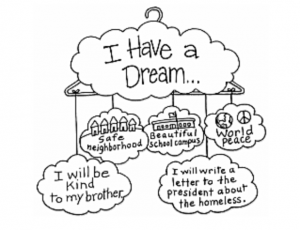
_________________________________________


_________________________________________
6. Share your STEAM mini spark recording page and your project with your teacher/EY coordinator.
#33: Martin Luther King, Jr.
 Dr. Martin Luther King Jr. Day. Celebrated on the third Monday in January, Martin Luther King Day is a national holiday that honors the United States’ most famous civil-rights activist.
Dr. Martin Luther King Jr. Day. Celebrated on the third Monday in January, Martin Luther King Day is a national holiday that honors the United States’ most famous civil-rights activist.
Spark your thinking!
1. Set up your social studies mini spark recording page: #33: Martin Luther King, Jr.
2. Watch the following video.
- Start the video.
- When you hear a date or a number mentioned, pause the video.
- Write down the date or number.
- Include a brief explanation of what it means.
- Resume the video when you are ready.
3. Martin Luther King was awarded the Nobel Peace Prize in 1964. Read this information page and record 5 details on your recording sheet.
4. Watch this short video. What small act of kindness or act of service can you do to celebrate Martin Luther King, Jr.?
5. Share your social studies mini spark recording page with your teacher/EY coordinator.
#44: I Have a Dream

Martin Luther King, Jr. was a civil rights activist in the 1950s and 1960s. He led non-violent protests to fight for the rights of all people including African Americans. He hoped that America and the world could become a colorblind society where race would not impact a person’s civil rights. He is considered one of the great orators of modern times, and his speeches still inspire many to this day.
Spark your thinking!
1. Set up your language arts mini spark recording page: #44: I Have a Dream
2. Add this information to your recording page
Dr. Martin Luther King, Jr.
- Occupation: Civil Rights Leader
- Born: January 15, 1929 in Atlanta, GA
- Died: April 4, 1968 in Memphis, TN
- Best known for: Advancing the Civil Rights Movement and his “I Have a Dream” speech
3. Read about Martin Luther King, Jr. at National Geographic Kids. Add a short summary for each section to your recording sheet.
4. Read this article and add 5 details to your recording sheet.
5. Read these Interesting Facts about Martin Luther King, Jr. On your recording sheet add 3 more facts that you found in your research.
- Dr. King was the youngest person to be awarded the Nobel Peace Prize in 1964.
- Martin Luther King, Jr. Day is a national holiday.
- At the Atlanta premier of the movie Gone with the Wind, Martin sang with his church choir.
- There are over 730 streets in the United States named after Martin Luther King, Jr.
- One of his main influences was Mohandas Gandhi, who taught people to protest in a non-violent manner.
- He was awarded the Congressional Gold Medal and the Presidential Medal of Freedom.
- The name on his original birth certificate is Michael King. This was a mistake, however. He was supposed to be named after his father who was named for Martin Luther, the leader of the Christian reformation movement.
- He is often referred to by his initials MLK.
6. Take a quiz to see how much you learned about this great man! Record your score on your recording page.
7. OPTIONAL Read or listen to Martin Luther King’s “I Have a Dream” speech. After reading/listening to the speech, record your thoughts on your recording page.
8. Share your language arts mini spark recording page and visual with your teacher/EY coordinator.
#43: Fermi jr- math warm up
If you have read the book Counting on Frank by Rod Clement then you are aware already of how a vivid imagination can bring to life a wide array of mathematics related to estimation, number, space, measurement, and chance and data ideas. In this math mini spark you will explore the story and work through some challenge problems.
Spark your math thinking!
1. Set up your math mini spark recording page: #112: Fermi math warm up
2. Listen to this story. On your recording page record 3 of the facts you thought were the most interesting.
3. Open this document or print it if you would like. Complete the math thinking on your recording page or on the document.
4. Share your math mini spark recording page with your teacher or EY coordinator.
The type of math you did in this mini spark is called Fermi math. Check out the FERMI math badges at the EY website.
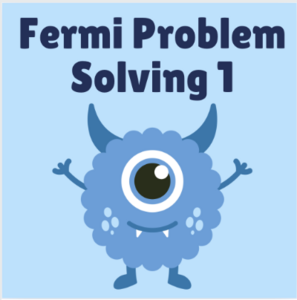
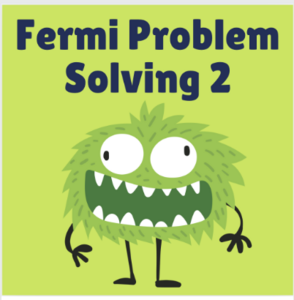
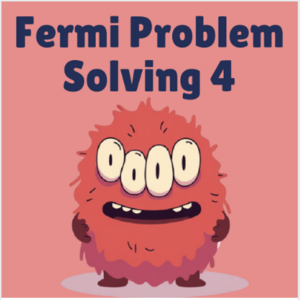

#32: The History of Snow
Explore 9 of the key developments in our love-hate history with the wonderful (awful) white stuff, snow.
Spark your thinking!
1. Set up your social studies mini spark recording page: #32: The History of Snow
2. Study the picture and read this paragraph. Answer the question that follows.
The Beginning: Paleolithic Era – Skiing for Survival
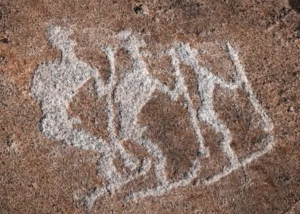
Ancient petroglyph.
Today, skiing is a fun activity winter-lovers can’t wait to take advantage of at the first sight of freshly fallen snow, but it was originally invented thousands of years ago as a means of survival. The first use of skis can be found in a cave painting dating back to the Paleolithic Era’s final Ice Age. The sticks that were used as the first prototype were not only helpful for traveling over frozen terrain, but also for hunting prey.
Describe how the original purpose of skiing differed from its use today. What survival needs did the early use of skis address?
3. Study the picture and read this paragraph. Answer the question that follows.
1565: Snowscapes in Paintings
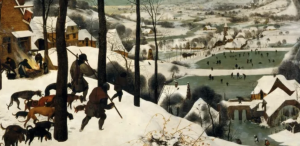
Pieter Bruegel the Elder, “Hunters in the Snow.”
Commonly seen as the first winter landscape painting, Pieter Bruegel the Elder painted “Hunters in the Snow” during the brutal winter of 1564-65. It was the longest and most severe winter Europe had seen in more than a century, kicking off what some called the “Little Ice Age.” If you can’t beat them, join them, right? After his first snow-scape Bruegel couldn’t stop painting ice and snow—he also painted the first scene with falling snow. His work started a winter-themed trend among Dutch painters that lasted for some 150 years.
In what ways did the severe winter of 1564-65 influence Pieter Bruegel the Elder’s artistic choices in “Hunters in the Snow”? Provide specific examples from the text to support your response.
4. Read this paragraph and answer the question that follows.
1717: “The Great Snow”
Events occurred either before or after “The Great Snow” of 1717 for generations of New Englanders. Starting in late February of that year, a series of storms dumped up to six feet throughout the region, with drifts as high as 25 feet! New Hampshire, Massachusetts and Connecticut got the worst of it: Entire houses were completely covered with snow, livestock perished and even Boston Puritans canceled church services for two weeks. But one intrepid postman refused to lose the battle, reportedly leaving his horse behind and donning a pair of snowshoes to make the arduous trip from Boston to New York.
How high is 25 feet? Do research to find 3 things that are 25 feet high.
5. Read this paragraph and answer the question that follows.
Early 19th century: A New Word is Born—Blizzard
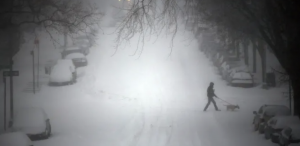
A person walks a dog through blizzard
The exact origins of “blizzard” are unclear, but it appears to have emerged as a non-snow-related noun. An 1829 article in the Virginia Literary Museum, a weekly journal published at the University of Virginia, defined the word as “a violent blow, perhaps from blitz (German: lightning).” In his 1834 memoir, Davy Crockett himself used the term to mean a burst of speech: “A gentleman at dinner asked me for a toast; and supposing he meant to have some fun at my expense, I concluded to go ahead, and give him and his likes a blizzard.” The first use of the word in reference to a severe snowstorm apparently came later. Etymologist and lexicographer Allen Walker Read believes the earliest such usage of “blizzard” was in an April 1870 issue of the Northern Vindicator, a newspaper in Estherville, Iowa.
Define “etymologist “and “lexicographer”.
6. Read this paragraph and answer the question that follows.
1862: The Rise of the Snow Plow
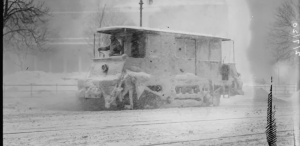
Today snow can mean long delays and canceled flights, but it used to be a positive thing for travel. When the main mode of transportation was the horse-drawn carriage, having packed snow on the roads made things easier, switching out their carriage’s wheels for ski-like runners when the snow piled up. Foot traffic was a different story, however, and by the mid-1800s several different inventors had patented their version of a horse-drawn snow plow to clear the alleys and walkways of America’s cities. In 1862, Milwaukee became the first major city to use such a plow, and its popularity spread quickly throughout the Snow Belt (the area stretching across the Great Lakes from Minnesota to Maine).
Describe the significance of Milwaukee’s use of the horse-drawn snow plow in 1862. How did this invention impact other cities in the Snow Belt?
7. Read this paragraph and answer the question that follows.
1878: Shakin’ It Up—The Snow Globe
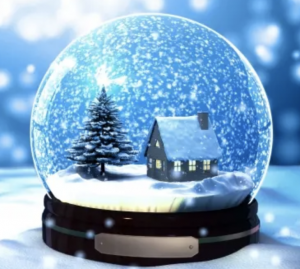
Indicative of the winter wonderland that fills the hearts of many each holiday season, the snow globe was first seen in France at the 1878 Paris Universal Exposition. The trinket gained little attention, however, and only found its way into the hearts and minds of holiday holiday-goers thanks to Edwin Perzy I. The mechanic accidentally created a snow globe in 1900, when he was asked to fix a dim light bulb. After noticing that water-filled glass globes would fill the entire room with light when placed in front of candle, he tried the same technique with a lightbulb but didn’t get the same results. Next he filled the globe with semolina flakes with the hope that they would help reflect the light, but instead it inspired him in a totally different way—the flakes reminded him of snow. Perzy patented the snow globe and the novelty caught on like wildfire.
Describe the accidental discovery made by Edwin Perzy I in 1900. What materials did he use, and how did they lead to the invention of the snow globe?
8. Read this paragraph and answer the question that follows.
1888: The Blizzard That Ate the Big Apple
Paralyzing the Northeast for over three days with snow, wind and freezing temperatures, horse-drawn plows stood no chance against the Blizzard of 1888. New York City was inundated with 50 inches of snow, along with high winds causing drifts of up to 40 feet—it was a snow-pocalypse. The city’s elevated railways—usually the only transport option during storms—were blocked leaving travelers stranded for days. The 1888 blizzard claimed 400 victims. It also did some good, however, by prompting cities to improve their snow removal procedures, including hiring more plows, assigning routes and starting the plowing process in the early phases of storms.
According to the text, what were some of the consequences of the Blizzard of 1888, both negative and positive?
9. Read this paragraph and answer the question that follows.
1920s: Snow Removal Goes Mobile
When automobiles replaced horse-drawn carriages on the roads, clearing the roads of snow became a big priority. Mechanized salt-spreaders helped, but weren’t sufficient. As early as 1913, some cities had started using motorized dump trucks and plows to remove snow. Chicago took it one step further in the 1920s, debuting a contraption called the “snowloader.” Equipped with a giant scoop and a conveyor belt, the device forced plowed snow up the scoop, onto the belt and into a chute that dropped it into a dump truck parked beneath. The snowloader revolutionized urban snow removal, making it a lot less labor-and time-intensive.
In what ways did the snowloader introduced by Chicago in the 1920s differ from previous methods of snow removal? Provide specific details from the text to support your answer.
1952: Introducing Your Very Own Snow Blower
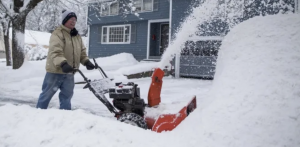
Snow blowing got personal in the early 1950s, when a Canadian company called Toro released the first human-powered snow blower. Other companies produced their own models during the 1960s, ushering in the age of modern snow removal. Around the same time, satellite weather technology was making it easier than ever to predict and prepare for storms, and widespread use of TV and radio helped keep the public aware of impending hazards caused by snow and wind.
In what ways do you believe the advancements in satellite weather technology during the 1960s changed how families prepared for winter storms? Have you ever had to prepare for a storm in your own life?
10. Read this paragraph and answer the question that follows.
Today: An Ode to the Humble Snow Shovel
Odds are the snow removal tool most people are familiar with is also the one that’s been around the longest—the shovel. Thought to date back some 6,000 years, the old-fashioned snow shovel remains one of the most effective tools for digging out of a blizzard, no matter where you live. Since the 1870s, more than 100 patents have been granted for snow shovel designs, as various people try their hand at improving on the time-honored classic.
The text mentions that more than 100 patents have been granted for snow shovels since the 1870s. Why do you think people have been motivated to create new designs for such a traditional tool?
11. Turn your social studies mini spark into your teacher/EY coordinator.
Lesson Source: https://www.history.com/news/humans-vs-snow-a-love-hate-history
#43: Precipitation Pensee Poem
 You already know that precipitation is any liquid or frozen water that forms in the atmosphere and falls back to the earth. It comes in many forms, like rain, sleet, and snow. Do you know what a Pensee Poem is? In this mini spark you will find out and write a poem about precipitation.
You already know that precipitation is any liquid or frozen water that forms in the atmosphere and falls back to the earth. It comes in many forms, like rain, sleet, and snow. Do you know what a Pensee Poem is? In this mini spark you will find out and write a poem about precipitation.
Spark your thinking!
1. Set up your language arts mini spark recording page: #43: Precipitation Pensee Poem
2. Read an article from Wonderopolis, “What’s the Best Thing to do on a Snow Day?”. What do you like to do on snow days? Make a list on your recording page.
3. Click on the video to listen and read along with The Cat in the Hat to see what Sally and her brother do on a rainy day! Make a list of what these two did on the rainy day.
4. Read this article all about sleet. Record 3 new facts on your recording page.
6. A pensee poem (pronounced pahn-say) is a 5-line, non-rhyming patterned poem that is both fun and easy to create! Go to this site and read the instructions and the example. Use the poem generator to create your own poem. Write the finished poem to your recording page or take a screenshot of the poem. Some kids like to write more than one. That is up to you.
OPTIONAL: Add illustrations to your poem
6. Share your language arts mini spark recording page and poem with your teacher/EY coordinator.
#32: Make Snowflakes
 Snowflakes are created in clouds when water droplets freeze around tiny particles in the air. These particles can be things like dust, pollen, smog, or soot. This process is known as nucleation. Water droplets need something to stick to in order to freeze, so they usually freeze around these small airborne particles.
Snowflakes are created in clouds when water droplets freeze around tiny particles in the air. These particles can be things like dust, pollen, smog, or soot. This process is known as nucleation. Water droplets need something to stick to in order to freeze, so they usually freeze around these small airborne particles.
Spark your thinking!
1. Set up your STEAM mini spark recording page: #32: Make Snowflakes
2. For each of the facts below, write the question and a summary of the information on your recording page.
Did you know that snowflakes come in all sizes?
The average snowflake ranges from a size slightly smaller than a penny to the width of a human hair. But according to some unverified sources they can grow much larger. Witnesses of a snowstorm in Fort Keogh, Montana in 1887 claimed to see milk-pan sized crystals fall from the sky. If true that would make them the largest snowflakes ever spotted, at around 15 inches wide.
Did you know that snow falls at 1 to 6 feet per second?
At least in the case of snowflakes with broad structures, which act as parachutes. Snow that falls in the form of pellets travels to Earth at a much faster rate.
Did you know that a little water can add up to a lot of snow?
The air doesn’t need to be super moist to produce impressive amounts of snow. Unlike plain rainfall, a bank of fluffy snow contains lots of air that adds to its bulk. That’s why what would have been an inch of rain in the summer equals about 10 inches of snow in the colder months.
Did you know that the snowiest city on Earth is in Japan?
Aomori City in northern Japan receives more snowfall than any major city on the planet. Each year citizens are pummeled with 312 inches, or about 26 feet, of snow on average.
Finally, did you know that snowflakes aren’t always unique?
Snow crystals usually form unique patterns, but there’s at least one instance of identical snowflakes in the record books. In 1988, two snowflakes collected from a Wisconsin storm were confirmed to be twins at an atmospheric research center in Colorado.
3. Now that you’ve learned all kinds of facts about snow, let’s use the “A” in “STEAM” to make some snowflakes! Watch the video tutorial below and make your own!
4. Add a picture of your snowflake to your recording page.
5. Share your STEAM mini spark recording page with your teacher/EY coordinator.
Check out the Story of Snow badge at the EY website.

Check out the science mini spark Snowflakes

#42: Snowflakes
When you make paper snowflakes, you can practice using scissors and get better at moving your hands! With practice, you can cut out even cooler and more complicated designs. Plus, these snowflakes look amazing and can make any room or window super pretty!
Spark your thinking!
1. Set up your Early Enrichment Mini Spark recording page: #42: Snowflakes
2. Read this infographic about snowflakes. How does a snowflake start? Why do snowflakes fall?
3. Gather your supplies to make your own paper snowflake.
Paper
Scissors
Pencil
4. Watch the tutorial below and then try it yourself!
5. Share your Early Enrichment Mini Spark recording page and your snowflake with your teacher or EY Coordinator.
Check out the Story of Snow badge at the EY website.

#41: Spooky Halloween Tongue Twisters
Tongue twisters are a great way to practice and improve pronunciation and fluency. They’re not just for kids, but are also used by actors, politicians, and public speakers who want to sound clear when speaking.
Spark your thinking!
1. Set up your Early Enrichment Mini Spark recording page: #41: Spooky Halloween Tongue Twisters
2. Look over this list of Spooky Halloween Tongue Twisters. Write down you favorite one.
- Creepy crawly critters crawl through creepy crawly craters.
- Dracula digs dreary, dark dungeons.
- Ghostly ghouls gather gleefully to golf on ghostly golf courses.
- Gobbling gargoyles gobbled gobbling goblins.
- Horribly hoarse hoot owls hoot howls of horror in Halloween haunted houses.
- If big, black bats could blow bubbles, how big of bubbles would big black bats blow?
- If two witches would watch two watches, which witch would watch which watch?
- Professional Pumpkin Pickers are prone to pick the plumpest pumpkins.
- Transylvanian Tree Trimmers are trained to trim the tallest Transylvanian trees.
- Several spooky, slimy spiders sulkily spun by the sea.
- The ochre ogre ogled the poker.
- Which witch wished which wicked wish?
3. Learn to say your tongue twister. Set you timer for 3 minutes and practice reading it aloud over and over. Start slowly. Work on saying each word carefully and clearly. Work up to being able to say your tongue twister quickly. As an adult to listen to you and initial your recording page.
4. Now that you’re an expert at saying one, write your own alliterative tongue twister.
- Pick a consonant.
- Write down as many words as you can think of that start with that letter. The more alike they sound, the better.
- Make up a sentence that uses as many of your words as possible.
5. Share your Early Enrichment Mini Spark recording page with your teacher or EY Coordinator.



